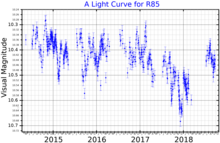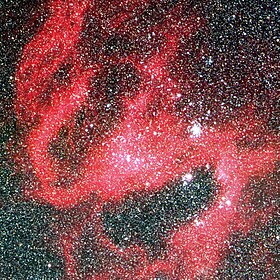R85 (or RMC 85, after the Radcliffe Observatory Magellanic Clouds catalog[5]) is a candidate luminous blue variable[9] located in the LH-41 OB association[10] in the Large Magellanic Cloud.

R85 has been shown to vary erratically in brightness with an amplitude of about 0.3 magnitudes. It shows variations on several timescales, sometimes with a distinct 400 day period. It has also shown temperature changes associated with brightness changes over several years, a characteristic of luminous blue variables.[12]
Based on R85's current properties and evolutionary models, it probably started out with an initial mass of 28 M☉.[10] It is theorized to be making a bubble known as DEM L132a with its stellar wind in the nebula LHA-120 N119, along with S Doradus.[13] It has an infrared excess consistent with a stellar wind contribution.[4]
References edit
- ^ a b c d e Cutri, Roc M.; Skrutskie, Michael F.; Van Dyk, Schuyler D.; Beichman, Charles A.; Carpenter, John M.; Chester, Thomas; Cambresy, Laurent; Evans, Tracey E.; Fowler, John W.; Gizis, John E.; Howard, Elizabeth V.; Huchra, John P.; Jarrett, Thomas H.; Kopan, Eugene L.; Kirkpatrick, J. Davy; Light, Robert M.; Marsh, Kenneth A.; McCallon, Howard L.; Schneider, Stephen E.; Stiening, Rae; Sykes, Matthew J.; Weinberg, Martin D.; Wheaton, William A.; Wheelock, Sherry L.; Zacarias, N. (2003). "VizieR Online Data Catalog: 2MASS All-Sky Catalog of Point Sources (Cutri+ 2003)". CDS/ADC Collection of Electronic Catalogues. 2246: II/246. Bibcode:2003yCat.2246....0C.
- ^ a b c d e f g h Ducati, J. R. (2002). "VizieR Online Data Catalog: Catalogue of Stellar Photometry in Johnson's 11-color system". CDS/ADC Collection of Electronic Catalogues. 2237. Bibcode:2002yCat.2237....0D.
- ^ a b c d e f g Van Genderen, A. M. (2001). "S Doradus variables in the Galaxy and the Magellanic Clouds". Astronomy and Astrophysics. 366 (2): 508–531. Bibcode:2001A&A...366..508V. CiteSeerX 10.1.1.459.5400. doi:10.1051/0004-6361:20000022. S2CID 55796300.
- ^ a b c Bonanos, A. Z.; Massa, D. L.; Sewilo, M.; Lennon, D. J.; Panagia, N.; Smith, L. J.; Meixner, M.; Babler, B. L.; Bracker, S.; Meade, M. R.; Gordon, K. D.; Hora, J. L.; Indebetouw, R.; Whitney, B. A. (2009). "Spitzersage Infrared Photometry of Massive Stars in the Large Magellanic Cloud". The Astronomical Journal. 138 (4): 1003–1021. arXiv:0905.1328. Bibcode:2009AJ....138.1003B. doi:10.1088/0004-6256/138/4/1003. S2CID 14056495.
- ^ a b Feast, M. W.; Thackeray, A. D.; Wesselink, A. J. (1960). "The brightest stars in the Magellanic Clouds". Monthly Notices of the Royal Astronomical Society. 121 (4): 337. Bibcode:1960MNRAS.121..337F. doi:10.1093/mnras/121.4.337.
- ^ a b Høg, E.; Fabricius, C.; Makarov, V. V.; Urban, S.; Corbin, T.; Wycoff, G.; Bastian, U.; Schwekendiek, P.; Wicenec, A. (2000). "The Tycho-2 catalogue of the 2.5 million brightest stars". Astronomy and Astrophysics. 355: L27. Bibcode:2000A&A...355L..27H.
- ^ Aldoretta, E. J.; Caballero-Nieves, S. M.; Gies, D. R.; Nelan, E. P.; Wallace, D. J.; Hartkopf, W. I.; Henry, T. J.; Jao, W.-C.; Maíz Apellániz, J.; Mason, B. D.; Moffat, A. F. J.; Norris, R. P.; Richardson, N. D.; Williams, S. J. (2015). "The Multiplicity of Massive Stars: A High Angular Resolution Survey with the Guidance Sensor". The Astronomical Journal. 149 (1): 26. arXiv:1410.0021. Bibcode:2015AJ....149...26A. doi:10.1088/0004-6256/149/1/26. S2CID 58911264.
- ^ Stahl, O.; Wolf, B.; Leitherer, C.; Zickgraf, F.-J.; Krautter, J.; De Groot, M. (1984). "Variable blue supergiants in the Large Magellanic Cloud - R 84, R 85, and R 99". Astronomy and Astrophysics. 140: 459. Bibcode:1984A&A...140..459S.
- ^ Richardson, Noel D.; Mehner, Andrea (2018). "The 2018 Census of Luminous Blue Variables in the Local Group". Research Notes of the American Astronomical Society. 2 (3): 121. arXiv:1807.04262. Bibcode:2018RNAAS...2..121R. doi:10.3847/2515-5172/aad1f3. S2CID 119509358.
- ^ a b Smith, Nathan; Tombleson, Ryan (2015). "Luminous blue variables are antisocial: Their isolation implies that they are kicked mass gainers in binary evolution". Monthly Notices of the Royal Astronomical Society. 447 (1): 598–617. arXiv:1406.7431. Bibcode:2015MNRAS.447..598S. doi:10.1093/mnras/stu2430. S2CID 119284620.
- ^ "ASAS-SN Variable Stars Database". ASAS-SN Variable Stars Database. ASAS-SN. Retrieved 6 January 2022.
- ^ Van Genderen, A. M.; Sterken, C.; De Groot, M. (1998). "Light variations of massive stars (alpha Cyg variables). XVI. The LMC supergiants R 85 (LBV) and R 110 (LBV) and the SMC supergiants R 42 and R 45". Astronomy and Astrophysics. 337: 393. Bibcode:1998A&A...337..393V.
- ^ Ambrocio-Cruz, P.; Rosado, M.; Laval, A.; Le Coarer, E.; Russeil, D.; Amram, P. (2008). "Kinematic field of the S-shaped nebula N119 in the LMC". Revista Mexicana de Astronomía y Astrofísica. 44: 355. Bibcode:2008RMxAA..44..355A.
